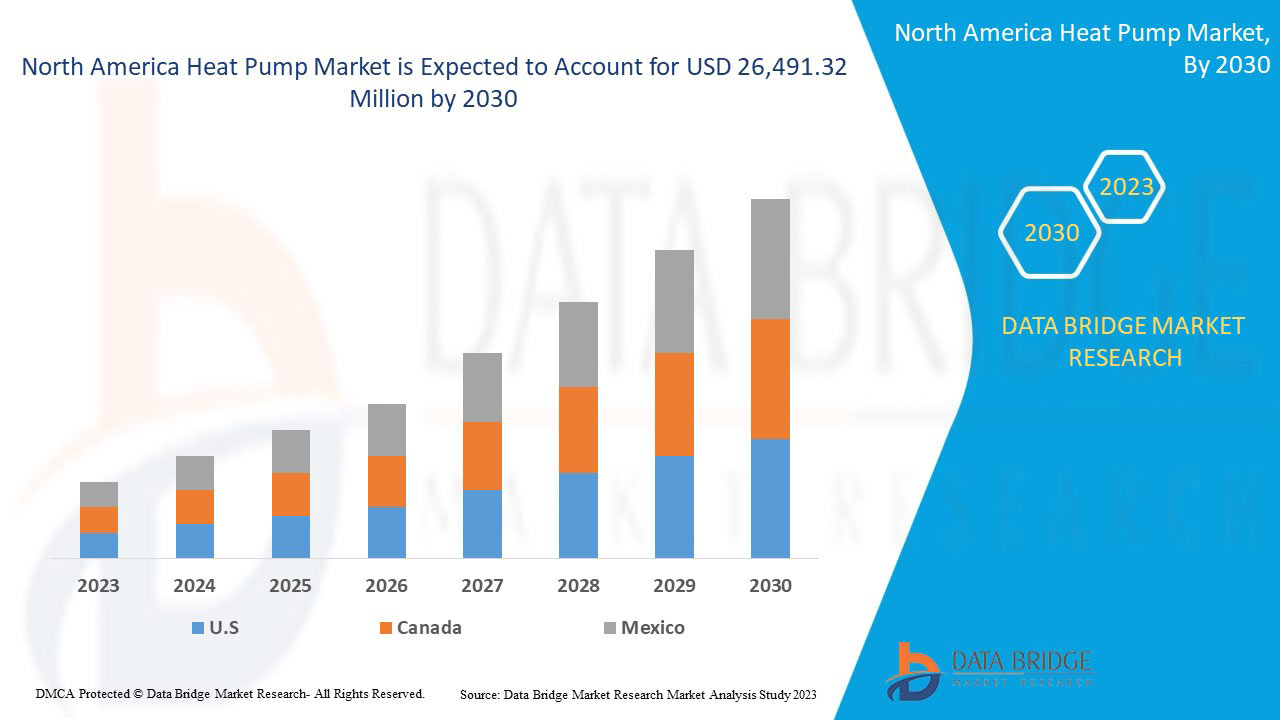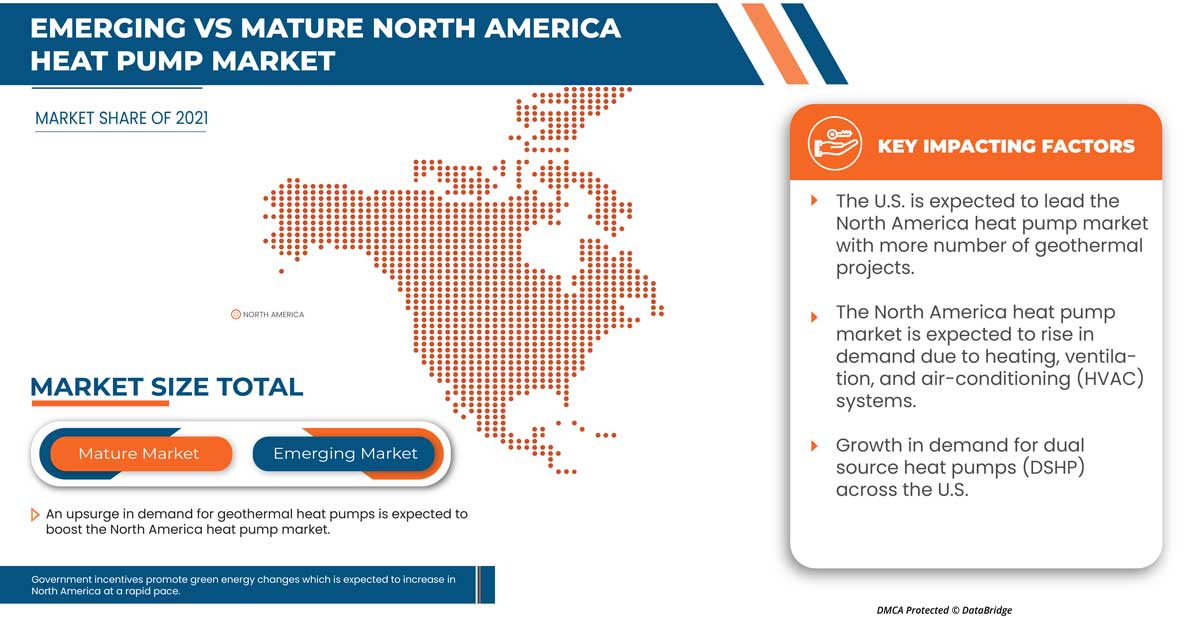North America Heat Pump Market, By Type (Air-To-Water Heat Pump, Air-To-Air Heat Pump, Water Source Heat Pump, Ground Source Heat Pump, and Hybrid Heat Pump), Component (Hardware, and Services), Capacity (Up to 10 kW, 10 to 20 kW, 20 to 30 kW, and Above 30 kW), Power Source (Electric, and Others), Refrigerant Type (R410A, R134A, R717 (Ammonia), R407C, R600 and R600A, R744, and Others), Cycle Type (Vapor Compression, Transcritical, and Absorption), System Type (Air Source Heat Pumps, Geothermal Heat Pumps, and Others), Application (Residential, Commercial, Industrial) Industry Trends and Forecast to 2030.

North America Heat Pump Market Analysis and Size
The North America heat pump market has witnessed growth due to the rising demand for heating, ventilation, and air-conditioning (HVAC) Systems. It can be used for numerous residential, commercial, and industrial applications in various industries such as general manufacturing, chemical and petroleum, food and beverages, utilities, textile and leather, wood products, metal, and others. The recent pandemic has slightly decreased growth across all sectors, but these systems have a huge potential to enhance industrial capabilities as these systems are the future. The North America heat pump market is in the rapid growth phase due to the growing demand for dual-source heat pumps (DSHP) across the U.S.

Data Bridge Market Research analyses that the heat pump market is expected to reach a value of USD 26,491.32 million by 2030, at a CAGR of 8.9% during the forecast period. "Air-to water heat pump" is the largest system segment in the heat pump market. The North America heat pump market report also covers pricing analysis, patent analysis, and technological advancements in depth.
|
Report Metric
|
Details
|
|
Forecast Period
|
2023 to 2030
|
|
Base Year
|
2022
|
|
Historic Years
|
2021 (Customizable to 2020 - 2015)
|
|
Quantitative Units
|
USD Pricing in Million
|
|
Segments Covered
|
By Type (Air-To-Water Heat Pump, Air-To-Air Heat Pump, Water Source Heat Pump, Ground Source Heat Pump, and Hybrid Heat Pump), Component (Hardware, and Services), Capacity (Up to 10 kW, 10 to 20 kW, 20 to 30 kW, and Above 30 kW), Power Source (Electric, and Others), Refrigerant Type (R410A, R134A, R717 (Ammonia), R407C, R600 and R600A, R744, and Others), Cycle Type (Vapor Compression, Transcritical, and Absorption), System Type (Air Source Heat Pumps, Geothermal Heat Pumps, and Others), Application (Residential, Commercial, Industrial).
|
|
Countries Covered
|
U.S., Canada, and Mexico.
|
|
Market Players Covered
|
Danfoss Industries Pvt. Ltd., Trane Technologies plc, NIBE Industrier AB, Midea Group, VIVRECO group, Robert Bosch GmbH, American Standard Heating and Air Conditioning (Brand of Trane Technologies plc), Lennox International Inc., Rheem Manufacturing Company, Goodman (A Brand of Daikin Comfort Technologies North America, Inc.), Thermax Limited., Mitsubishi Electric Corporation, DAIKIN INDUSTRIES, Ltd., Carrier., Johnson Controls, RUUD (Brand of Rheem Manufacturing Company), BRYANT (Brand of Carrier.), among others.
|
Market Definition
Heat pumps offer an energy-efficient alternative to furnaces and air conditioners for all climates. Like your refrigerator, heat pumps use electricity to transfer heat from a cool space to a warm space, making the cool space cooler and the warm space warmer. Heat pumps move heat from the cool outdoors into your warm house during the heating season. Heat pumps move heat from your house into the outdoors during the cooling season. Because they transfer heat rather than generate heat, heat pumps can efficiently provide comfortable temperatures for your home.
North America Heat Pump Market Dynamics
This section deals with understanding the market drivers, advantages, opportunities, restraints, and challenges. All of this is discussed in detail below:
Drivers
- Rise in demand for heating, ventilation and air-conditioning (HVAC) systems
The heating, ventilation, and air-conditioning (HVAC) systems play a major role in the advanced ventilation systems and technologies adopted to improve air quality and balance excess moisture and various types of contamination. Adopting mathematical models, computer simulation technology, and other techniques involve integrating mechanical components and a digital user interface for easy operation. Hence, this type of system and technology are interdependent. Thus, the development of advanced HVAC depends upon the good and proper usage of heat pump-related components.
- Grow in demand for dual source heat pumps (DSHP) across the U.S.
Moreover, dual-source heat pumps extract energy from natural sources such as the sun and ground. These are available in multiple designs. Solar-assisted air source heat pumps are mostly available in developed countries such as the U.S., Canada, and Mexico. This type of dual-source heat pump is more efficient during colder weather because there is less heat for the heat pump to extract from the outdoor air. This feature will provide dynamic response facilities increasing usage.
Restraint/Challenge
- Complexities in heat pumps retrofits
Modern heat pump systems include the rise in complexities related to retrofitting heat pumps. The air source heat pumps are inherently at the critical stage due to changing technology with the manufacturing process and quality of the end product. These heat pumps are associated with crucial equipment so that energy-efficient sources can be utilized to generate heat.
Opportunity
- Shift in consumer preference towards the sustainable solution for residential and commercial use
Moreover, the amount of electricity required by eco-friendly geothermal heat pumps is significantly lower, affecting the working efficiency of the heat pump operations. The primary advancement in heat pumps is the compressor, a game-changing aspect. As the world focuses on reducing greenhouse gas emissions, heat pumps are readily available solutions to meet the demand for sustainable space and water heating. This has improved the accuracy and working features of the heat pumps.
Post-COVID-19 Impact on the North America Heat Pump Market
COVID-19 significantly impacted the heat pump market as almost every country has opted to shut down every production facility except those producing essential goods. The government has taken some strict actions, such as shutting down the production and sale of non-essential goods, blocking international trade, and many more to prevent the spread of COVID-19. The only business dealing with this pandemic is the essential services allowed to open and run the processes.
Manufacturers are making various strategic decisions to bounce back post-COVID-19. The players are conducting multiple research and development activities to improve the technology in the heat pump market. The companies will bring advanced and accurate solutions to the market. In addition, the government initiatives to boost international trade have led to the market's growth.
Recent Developments
- In April 2021, Thermax Limited signed an agreement with power roll to develop the market for solar film in India. The companies agreed to develop solar energy instruments. The main objective of the companies was to contribute towards a green solution. The companies will be able to expand their product portfolio and attract a new customer base.
- In April 2022, DAIKIN INDUSTRIES, Ltd announced the acquisition of DUPLOMATIC MS S.P.A. the acquisition was decided to start manufacturing hydraulic-related equipment. The acquisition will help diversify the product portfolio and have a business in a wide range of fields. Companies took the step to expand their product portfolio and increase the profit margin and workforce of the company.
North America Heat Pump Market Scope
The North America heat pump market is segmented based on type, component, capacity, power source, refrigerant type, cycle type, system type, and application. The growth amongst these segments will help you analyze meager growth segments in the industries and provide the users with a valuable market overview and market insights to help them make strategic decisions for identifying core market applications.
By Type
- Air-To-Water Heat Pump
- Air-To-Air Heat Pump
- Water Source Heat Pump
- Ground Source Heat Pump
- Hybrid Heat Pump
On the basis of type, the North America heat pump market is segmented into air-to-water heat pump, air-to-air heat pump, water source heat pump, ground source heat pump, and hybrid heat pump.
By Component
- Hardware
- Services
On the basis of component, the North America heat pump market has been segmented into hardware and services.
By Capacity
- Up to 10 kW
- 10 to 20 kW
- 20 to 30 kW
- Above 30 kW
On the basis of capacity, the North America heat pump market has been segmented into Up to 10 kW, 10 to 20 kW, 20 to 30 kW, and above 30 kW.
By Power Source
- Electric
- Others
On the basis of power source, the North America heat pump market has been segmented into electric and others.
By Refrigerant Type
- R410A
- R134A
- R717 (Ammonia)
- R407C
- R600 and R600A
- R744
- Others
On the basis of refrigerant type, the North America heat pump market has been segmented into R410A, R134A, R717 (Ammonia), R407C, R600 and R600A, R744, and others.
By Cycle Type
- Vapor Compression
- Transcritical
- Absorption
On the basis of cycle type, the North America heat pump market has been segmented into vapor compression, transcritical, and absorption.
By System Type
- Air Source Heat Pumps
- Geothermal Heat Pumps
- Others
On the basis of system type, the North America heat pump market has been segmented into air source heat pumps, geothermal heat pumps, and others.
By Application
- Residential
- Commercial
- Industrial
On the basis of application, the North America heat pump market has been segmented into residential, commercial, and industrial.
North America Heat Pump Market Regional Analysis/Insights
The North America heat pump market is analyzed, and market size insights and trends are provided by country, type, component, capacity, power source, refrigerant type, cycle type, system type, and application, as referenced above.
Some countries covered in the North America heat pump market report are the U.S., Canada, and Mexico. The U.S. is expected to dominate the North America heat pump as it is at the forefront of technology development and sustainable development in the region.
The country section of the report also provides individual market-impacting factors and market regulation changes that impact the market's current and future trends. Data points like downstream and upstream value chain analysis, technical trends and porter's five forces analysis, and case studies are some of the pointers used to forecast the market scenario for individual countries. Also, the presence and availability of North American brands and their challenges faced due to large or scarce competition from local and domestic brands, the impact of domestic tariffs, and trade routes are considered while providing forecast analysis of the country data.
Competitive Landscape and North America Heat Pump Market Share Analysis
The North America heat pump market competitive landscape provides details by the competitor. Details included are company overview, company financials, revenue generated, market potential, investment in research and development, new market initiatives, North America presence, production sites and facilities, production capacities, company strengths and weaknesses, product launch, product width and breadth, and application dominance. The above data points provided are only related to the companies' focus related to the North America heat pump market.
Some of the major players operating in the North America heat pump market are Danfoss Industries Pvt. Ltd., Trane Technologies plc, NIBE Industrier AB, Midea Group, VIVRECO group, Robert Bosch GmbH, American Standard Heating and Air Conditioning (Brand of Trane Technologies plc), Lennox International Inc., Rheem Manufacturing Company, Goodman (A Brand of Daikin Comfort Technologies North America, Inc.), Thermax Limited., Mitsubishi Electric Corporation, DAIKIN INDUSTRIES, Ltd., Carrier., Johnson Controls, RUUD (Brand of Rheem Manufacturing Company), BRYANT (Brand of Carrier.), among others.
SKU-

